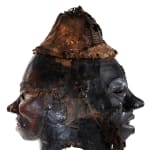 Double-Faced Helmet Mask
Double-Faced Helmet Mask
 Double-Faced Helmet Mask
Double-Faced Helmet Mask
 Double-Faced Helmet Mask
Double-Faced Helmet Mask
 Double-Faced Helmet Mask
Double-Faced Helmet Mask
Anonymous Ejagham artist
origin: Nigeria - early 20th century
19 3/4 x 17 3/8 x 9 7/8 in
Further images
Among the Ejagham, in the vicinity of the Cross River, social control has been in the hands of secret societies, rather than political leaders. This double-faced mask was associated with a military secret society, the Ekpe, that exercised the political and economic power in the local community. Such masks were performed during burial rituals, public seasonal festivals throughout the year, and the society’s initiation rituals. As a designated time, the beating of the village’s largest drum, marked the beginning of the soldier’s secret society’s masquerades. A messenger announced that the society’s spiritual being, the Okun, had come to the village, and performances would be held in his honor.
The technique of covering carved wooden helmet masks with skin is unique to the area along the Cross River, which straddles the border between Nigeria and Cameroon. Artists used antelope skin softened by a lengthy soaking in water. The skin was then stretched over the carved wooden form and bound and pegged in place, where it eventually dried and stiffened. A glossy surface was achieved by rubbing the headdress with palm oil prior to its performance. The performer wore a long gown of string netting or cotton cloth. His costume was to impress the uninitiated viewer by creating an aura of mystery and a sense of fear. Between performances, the mask was wrapped and stored with great care.
This exceptional example features two fierce faces in opposing directions, often referred to as a janus face. The term “janus-faced” comes from the Roman god Janus, who was the patron of beginnings and endings. Such a double face has several levels of meaning among the Ejagham peoples. One side shows a light-colored leather symbolizing women, and life in general. The other face has a blackish painted leather, denoting men, death, and the afterlife. It should be noted that only the eyes of the masculine side are open, to allow the wearer to see his surroundings while performing. These awe-inspiring, unsettling double-faced helmet masks also conveyed the ability to simultaneously see what was in front and behind, to discern connections between past and future events, and to observe both the human and spiritual worlds.
A related double-sided helmet mask collected by Alfred Mansfeld between 1904 and 1907, now held by the Berlin Museum (III.C.20.468), shows the feather cap that originally would be worn by the present mask. A helmet mask created by the same anonymous Ejagham artist is owned by the Belgian artist/collector Jan Calmeyn.
Provenance
Abdoulaye Ousmane, Lomé, Togo
Private Collection, 2002
Christie's, Paris, 15 June 2002. Lot 72,
Pierre Loos, Brussels, 2006
Bernard Dulon, Paris; France
Private Collection
Native-Online Auctions, 30 May 2016. Lot 007.
Private Collection
Native Online Auctions, Brussels, 21 May 2018. Lot 050.
Private Collection
Exhibitions
"Cameroun", Galerie Bernard Dulon, Paris, 16 June-30 September 2006












